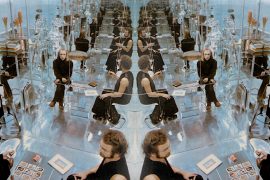Below is Tom Abba’s response to the first ambient literature research team meeting. Read more about it from Jon Dovey and Amy Spencer.
* * *
I had a beer with Duncan Speakman last night. Duncan’s starting to put the shape of his commission for Ambient Literature together and amongst the vagaries of location responsive storytelling, he asked me a question:
I still don’t understand what the book has to do with Ambient Literature?
And I paused. I thought (as an academic involved in a two year research programme is supposed to do) and then I talked about Ian Gadd’s presentation earlier that afternoon.
What is a book?
On the one hand, that’s an easy question to answer. A book is a collection of pages (sometimes collected in sections) stitched or glued together and bound with board (or card) to provide a cover. It’s a codex, a container for ideas. It can be so much more than that though….
Working with Duncan (and others) I’ve made books that don’t behave like books. Books that occupy a space within what Ian was getting at with Leslie Howsam’s definitions of the book as a material object and also as an experience. Books that use interdependent physical and digital layers of storytelling to do things that a conventional book can’t do.
Ian discussed The panther-prophesy, or, A premonition to all people, of sad calamities and miseries like to befal these islands. Published in 1662, this pamphlet draws on Revelations to deliver a parable drawing on contemporary political concerns.

What’s especially exciting about this work is the way the Panther Prophesy uses the confines of the page itself to suggest reading in a specific, very modern way. The kind of typographic manipulation that wouldn’t become commonplace until the end of the 20th Century was exhibited in the 17th. Each element visible on those pages – set by hand and not by a copy of inDesign mind you – was placed by a designer who grasped devices in use in contemporary graphic novels and experimental literature. It challenges, or changes the role of the reader in relation to the text and the object. In our project too, the reader’s status as a part of a cultural transaction (in that, for Howsam, a book, or a story, arguably needs a reader or a listener in order to manifest its meaning) is altered if we’re proposing that their presence in a specific site or situation is contingent on the story being told. We can address exactly how they are reading, requiring them to pay attention in a way not usually foregrounded in a conventional form. The act of reading can shift into a performative space.
That’s the best answer I have for Duncan right now. We’re interested in how we can retain the affordances of the book – as a piece of design it’s unparalleled – but we want to draw on reader expectations and familiarities as much as we challenge them too. We can only build something new if readers understand how to use it without a manual.
— Tom Abba
(Read Jon Dovey’s thoughts on Ian’s presentation here.)








Comments are closed.